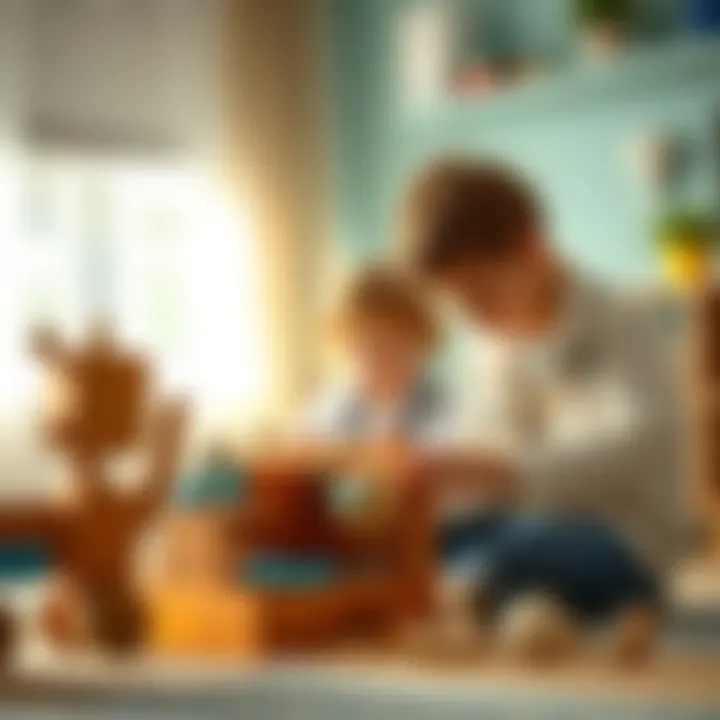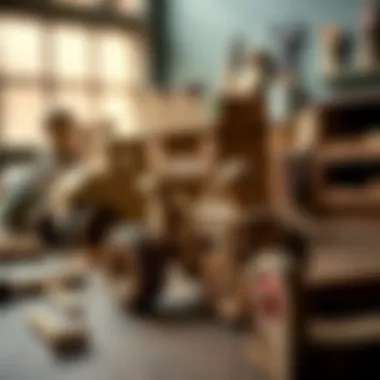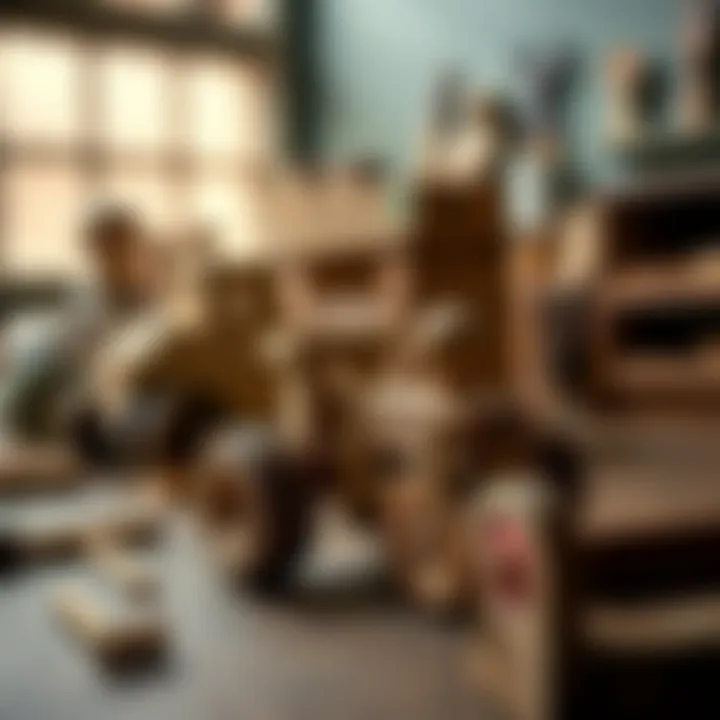The Role of Wooden Toy Doctor Kits in Child Growth


Intro
In the bustling realm of childhood play, wooden toy doctor kits stand out as not just mere toys, but as vital instruments that promote holistic child development. Children aren’t just playing; they’re stepping into new roles that ignite their imaginations, hone their social interactions, and stimulate their cognitive growth. This article embarks on a journey through the various ways these thoughtfully designed kits contribute to essential life skills, while also examining the craftsmanship behind these toys and their alignment with sustainable practices.
When a child picks up a wooden stethoscope, they’re not merely engaging in pretend play; they're exploring concepts of empathy, responsibility, and problem-solving. This transformative play is crucial during early childhood when minds are most impressionable. In the following sections, we’ll delve into the cognitive, emotional, and social benefits afforded by wooden doctor kits. Additionally, we will touch upon the craftsmanship involved, ensuring safety, and the importance of sustainability in today’s toy market.
As we dissect these points, parents and educators can gain insights into how to enrich children’s playtime with deeper, more meaningful experiences. Through understanding the significance of these toys, families can pivot towards enriching their children’s worlds while also fostering a creative space that nurtures growth.
Preface to Wooden Toy Doctor Kits
As we step into the realm of childhood play, wooden toy doctor kits should not just be seen as simple toys; they are fundamental tools for developing essential skills in young children. These kits provide a springboard for imaginative play, allowing kids to step into the shoes of a caregiver or a medical professional, fostering both creativity and learning.
The journey of childhood is a complex tapestry of learning experiences, and wooden toy doctor kits offer a unique intersection of play and education. In an age where digital distractions loom large, the tangible, tactile quality of wooden toys often brings children back to basics, engaging their senses while providing a rich platform for exploration.
Why Focus on Wooden Toy Doctor Kits?
- Cognitive Development: Playing with these kits encourages critical thinking and imagination. Understanding how various tools work, like a stethoscope or a syringe, boosts problem-solving skills.
- Social Skills: Engaging in role-play with peers allows children to practice empathy and communication, paving the way for cooperation and teamwork.
- Emotional Growth: The act of pretending to care for dolls or stuffed animals teaches compassion and nurturance, shaping emotional intelligence.
More than mere items, these wooden toy doctor kits embody a hands-on method of learning. They stimulate conversations about health, responsibility, and care while nurturing a child's ability to express emotions. The small intricacies of using a wooden thermometer or pretending to administer a check-up cultivate skills that extend well beyond playtime.
Thus, the significance of wooden toy doctor kits cannot be overstated. These kits serve as a vital tool in nurturing a well-rounded child who is not only knowledgeable about the world around them but also considerate and cooperative.
By understanding how these toys intertwine with various domains of childhood development, we can appreciate their value more deeply. Moving forward, let’s delve into what exactly constitutes a wooden toy doctor kit in the next section.
Educational Benefits of Play
Playing with toys, like wooden doctor kits, serves as much more than mere pastime for children. It plays a crucial role in their learning process, facilitating skills that are foundational to their overall development. When children engage in role-playing, they absorb knowledge and refine abilities naturally through the very act of play. This aspect has major implications spanning cognitive, emotional, and social domains.
Cognitive Development
Critical Thinking Skills
Engaging with a wooden toy doctor kit promotes critical thinking skills in children. When they role-play as doctors, they’re not just acting out scenarios; they’re making decisions that require thoughtful analysis. For example, if a child pretends to treat a stuffed animal, they must assess the ‘patient’s’ condition and determine what ‘treatment’ to administer. Such scenarios foster the capability to evaluate circumstances and choose the best course of action.
This unique feature of critical thinking through play helps children learn to analyze a situation before jumping to conclusions. As a result, this not only develops intellect but also nurtures a child’s curiosity and enhances their ability to think independently.
Problem-Solving Abilities
Problem-solving abilities are sharpened as children navigate through different play scenarios with their doctor kits. Encountering various challenges in their role of a toy doctor, kids might face the dilemma of how to fix a limp toy dog or soothe a crying doll. Each challenge requires them to brainstorm multiple solutions, analyze the outcome of their decisions, and adapt accordingly. This iterative process of trial and error is at the heart of effective problem-solving. The beauty of this play lies in its capacity to teach flexibility. Children learn that problems can have multiple answers, nurturing a sense of resilience and confidence in facing obstacles. Rather than being deterred by failure, they tend to embrace it as a stepping stone to success.
Emotional and Social Growth
Empathy and Compassion
Through engaging with wooden toy doctor kits, children cultivate empathy and compassion. Pretending to be a doctor involves understanding the ‘feelings’ of the toy patients and the context of their care. As they practice ‘diagnosing’ and ‘treating’ their toys, they learn to relate to emotions in a playful yet meaningful way. The act of offering care, even to inanimate objects, hones their ability to empathize with others. This understanding transcends play, fostering emotional intelligence that will benefit them in real-life interactions. It effectively creates a foundation upon which strong interpersonal relationships can be built.
Collaboration and Teamwork
When children play together, particularly with toys like doctor kits, they engage in collaborative efforts that enhance their teamwork skills. Taking turns being doctor or patient, negotiating roles, and deciding what to do next drives cooperation. Such interactions are vital to learning the art of compromise and communication. The distinctiveness of learning teamwork through playing with wooden toys is that it lays groundwork for future collaborative endeavors. Early experiences in working together help children develop patience and understanding in social relationships. They learn that every player in the game contributes to the overall experience, which is essential for collective success.
As children explore and interact with their surroundings through play, they not only learn about the world around them but also about themselves. Wooden toy doctor kits serve as a vital educational tool, bridging the gap between fun and learning.
Components of a Typical Wooden Toy Doctor Kit
When diving into the world of wooden toy doctor kits, it’s crucial to unravel the specific components that make these kits both functional and enriching for children. Each tool serves more than just a purpose; it nurtures various aspects of child development and play. By examining the myriad accessories and design elements, we can appreciate their significance in fostering a child's creativity, imagination, and learnings.
Common Tools and Accessories
Stethoscope


The stethoscope is perhaps the most iconic tool in any toy doctor's kit. This special instrument offers children a way to explore their understanding of health and the human body. What sets the toy stethoscope apart is its design that mimics the real deal while being entirely child-friendly. Children can "listen" to their dolls or stuffed animals, nurturing their curiosity about medical practices.
One distinctive feature of a wooden toy stethoscope is its lightweight, allowing even the youngest doctors to handle it with ease. This accessibility contributes to a sense of achievement as children take on inspiring roles, deploying imaginative narratives during play. However, it’s important to note the limitations: without actual sound functionality, it may not be engaging enough for every child, particularly those who may be more inclined towards realistic play. Still, its symbolic nature enriches creative scenarios and allows kids to enact roles they observe in the adult world.
Thermometer
During playtime, the thermometer element of a toy doctor kit allows children to engage specifically with the concept of health monitoring. Typically a vibrant piece, children can take "temperature checks" on their patients to assess their wellbeing. The unique aspect of a wooden thermometer is that it often distinguishes between different colors displaying various "temperatures," engaging kids visually and cognitively to understand better how teething or illness can be measured.
Wooden thermometers, designed to fit easily in small hands, promote fine motor skills while integrating educational aspects into the play. Its bright colors and user-friendly structure capture attention and spark conversations, guiding children to learn through doing. While some might consider the lack of realism a shortcoming, the pretend aspect is central to imaginative play. The thermometer stands as an excellent tool for introducing fundamental healthcare concepts essential for early childhood education.
Design and Aesthetics
The aesthetic elements of wooden toy doctor kits play a significant role in how children connect with the tools, enhancing both their appeal and educational value.
Color Schemes
Color schemes in toy design aren't just for visual delight; they can significantly affect a child's engagement and emotional response. In wooden toy doctor kits, bright, inviting colors often dominate, making the tools seem more lively and approachable. These colors can stimulate a child's imagination, sparking joy and creativity while they enact their roles. A classic choice of colors often includes combinations of bold primary shades, making it easier for kids to identify their favorite tools.
Each color in a toy set can also signal different purposes. For instance, a red stethoscope might evoke thoughts of urgency, while a blue thermometer might bring about feelings of calm. This connection can foster discussions about feelings, emotions, and basic medical terminologies among children, proving beneficial for their overall comprehension. Despite this, the challenge remains: not every child prefers bold colors, so balancing aesthetics can prove trickier.
Material Usage
When talking about the materials in wooden toy doctor kits, we’re not just discussing durability but also the safety and tactile experience they provide. Wood as a material offers warmth and an organic feel that plastic simply can’t replicate. This tactile experience encourages children to explore their surroundings through physical interaction, as wood often invites touch and grip. Beyond the feel, the natural resistance of wood to wear and tear creates a lasting impact, ensuring longevity in play.
The eco-friendly aspect of choosing wood as a primary material cannot go unmentioned. Parents increasingly prioritize sustainable toys to minimize their environmental footprint, making wooden toys more attractive. While most wooden toys undergo smart craftsmanship with non-toxic finishes, there can be concerns regarding splintering or the sustainability of wood sources. A close look into these elements, however, usually reveals that reputable manufacturers adopt responsible practices to ensure quality.
Sustainable Practices in Toy Manufacturing
In the realm of toy production, embracing sustainable practices is paramount for both environmental and developmental reasons. The use of eco-conscious methods and materials in creating wooden toy doctor kits not only speaks to the values of quality and safety but also demonstrates a commitment to reducing the ecological footprint. Parents and educators are increasingly prioritizing sustainability, recognizing that the toys children play with can have significant impacts on their well-being and the planet's health.
Eco-friendly Materials
Sources of Wood
When sourcing wood for toy manufacturing, it’s imperative to consider options that are sustainable, such as bamboo or reclaimed timber. Bamboo, a highly renewable resource, can grow rapidly, making it a favored choice among environmentally conscious manufacturers. Likewise, reclaimed wood—derived from old structures or furniture—adds character and often retains fewer chemicals than newly sourced wood.
The unique feature of these sources is their minimal impact on forests and ecosystems. There’s less deforestation involved, which is increasingly vital as habitats disappear and climate change looms. Using responsibly harvested wood helps ensure that wooden toy productions contribute positively to their environments. However, some drawbacks include higher costs and the need for thorough inspections of reclaimed materials to avoid hidden hazards.
Non-toxic Finishes
In addition to selecting the right wood, the finishes applied to wooden toy doctor kits are crucial for child safety. Many manufacturers utilize non-toxic, water-based finishes that are safe for children and the environment. This characteristic is particularly important since young children often explore their surroundings through touch and taste.
Non-toxic finishes typically lack harmful chemicals often found in traditional paints and sealants, ensuring that children are playing with safe materials that won’t affect their health. The advantage of these eco-friendly finishes is that they can enhance the toy's appearance while being totally safe for little hands. However, the major downside is that some non-toxic finishes may require more frequent reapplication since they may not endure as long as conventional ones.
Manufacturing Processes
Reducing Waste
The toy manufacturing process can generate significant amounts of waste. Implementing practices aimed at reducing this waste is essential for a more sustainable production model. Many wood manufacturers have adopted lean manufacturing techniques, which focus on minimizing waste through efficient processes.
This method not only conserves resources but also leads to less scrap material ending up in landfills. Additionally, reducing waste translates to lower production costs and improved efficiency, making it an appealing strategy for manufacturers. On the downside, some smaller companies might struggle with the resources needed to completely overhaul their existing processes, which can limit their ability to adopt more sustainable approaches.
Energy Efficiency
An equally vital component of sustainability in toy manufacturing is energy efficiency. Many manufacturers are integrating renewable energy sources into their operations, such as solar or wind power, to decrease their reliance on fossil fuels. This shift to energy-efficient processes reduces greenhouse gas emissions and often lowers energy costs in the long run. One intriguing aspect is that these energy-efficient practices can also attract eco-conscious consumers who are eager to support businesses that align with their environmental values. However, transitioning to energy-efficient systems often comes at a high initial investment cost, which can deter small-scale manufacturers or startups.
"By focusing on sustainable practices, we not only support healthy child development but also prioritize the planet's future for generations to come."
In summary, sustainable practices in toy manufacturing extend beyond environmental interests; they shape the way future generations learn to interact with the world. Through the use of eco-friendly materials and improved manufacturing processes, wooden toy doctor kits embody a commitment to quality, safety, and sustainability.
Safety Standards for Children's Toys
When it comes to toys, particularly those aimed at young children, safety cannot be an afterthought. In the realm of wooden toy doctor kits, establishing and adhering to robust safety standards is crucial for ensuring that the play experience contributes positively to child development without compromising well-being.


Many parents feel a sense of unease when it comes to toys, fearing hidden hazards that could pose risks. For instance, sharp edges or splinters can turn a seemingly innocent toy into a source of injury. It’s here where safety standards lay down the law, guiding manufacturers on what materials and designs are acceptable. Meeting these benchmarks cultivates trust between parents and toy makers, allowing for a safer playground at home.
- Importance of Safety Standards
- They protect children from potential hazards that may arise from poorly made toys.
- They provide guidelines for durable materials that withstand everyday wear and tear, reducing the likelihood of breakage.
- They set limits on harmful substances, ensuring toys are free from toxic chemicals.
"Buying toys is not just about fun; it’s about ensuring they are built on a foundation of safety and trust."
Regulatory Guidelines
Regulatory guidelines serve as the backbone for safety standards across various regions. For wooden toy doctor kits, these regulations generally dictate parameters such as design, material sourcing, and performance testing. In the United States, for example, the Consumer Product Safety Commission (CPSC) outlines what constitutes a safe toy.
Some essential aspects of these guidelines include:
- Material Quality: Toys must be made from non-toxic finishes, and the wood used should be sustainably sourced, limiting the exposure to harmful substances.
- Design Specifications: Toys are designed to avoid small parts that can present choking hazards to infants.
- Testing Procedures: Regular safety tests help in identifying risks before the products reach the shelves.
Quality Control Measures
After creating a toy that meets regulatory guidelines, quality control measures are deployed to ensure these standards are maintained consistently. Quality assurance isn’t just a one-time check; it’s an ongoing commitment throughout the toy's life cycle.
Key components of quality control for wooden toy doctor kits may include:
- Batch Testing: Regular testing of toy production batches ensures adherence to safety norms. Each batch undergoes scrutiny to identify any deviations from the norm.
- Inspection Protocols: Visual inspections help identify any defects such as rough surfaces or improper assembly, addressing issues while toys are still in production.
- Feedback Loops: Manufacturers often take into account customer feedback and incorporate improvements based on real-world experiences.
By weaving these elements together, they not only check their boxes for compliance but build a solid reputation among conscientious consumers focused on quality and safety.
Navigating the world of children's toys doesn't have to be fraught with fear. Understanding the layers of safety standards can embolden parents and caregivers to make informed decisions that prioritize both enjoyment and safety for little ones.
The Impact of Role-Playing on Child Psychology
Role-playing stands out as a vital tool in a child's developmental journey. When children engage in imaginative scenarios, like playing doctor with wooden toy doctor kits, they tap into their emotional and cognitive faculties in ways that mere observation or rote learning can't achieve. This act of stepping into someone else's shoes fosters essential skills that profoundly impact their psychological growth.
Imitative Learning
Imitative learning is a key aspect of how children understand and internalize the world around them. When kids use wooden toy doctor kits, they observe, mimic, and recreate interactions that are often seen in real-life contexts, such as healthcare settings. This imitation fosters a deeper comprehension of social roles and behaviors, which is crucial for social integration and emotional understanding.
Through imitative play, children start to grasp complex concepts like empathy and care. For instance, when a child uses a stethoscope on a stuffed animal, they reflect what they have witnessed adult relatives do, perhaps during a visit to a doctor's office. This kind of play allows kids to practice compassion in a controlled and safe environment, reinforcing their understanding of emotional responses both for themselves and for others. It’s not just fun; it’s learning entrenched in behavior and thought.
Creating Narratives
Another significant aspect of role-playing is the ability to create narratives. As children manipulate their toy doctor kits, they spin stories that reflect their curiosities, fears, and experiences. This storytelling lays the foundation for cognitive development, enhancing their verbal skills and imagination.
Creating narratives encourages children to make sense of their surroundings and plot their response to different situations. A young child might announce that their teddy bear has a "big cough," leading to a detailed narrative about diagnosing and treating their furry patient. Such discussions don’t only display imagination - they help a child learn how to express concepts and emotions verbally.
Moreover, weaving stories during play allows for the exploration of different outcomes, cultivating critical thinking. Children learn the importance of actions and consequences as they navigate through their tales. Through fictional scenarios, they can simulate responses and rehearse how they might react in real situations, all while boosting their creativity and problem-solving abilities.
"Role-playing in childhood is not merely about playing; it's constructing this playground of imagination where the possibilities are limitless, and the psychological benefits are invaluable."
In summary, the impact of role-playing on child psychology is multifaceted. With the use of wooden toy doctor kits, children not only learn through imitation but also through the creation of immersive narratives that engage their minds and hearts. As they role-play, they're not just passing time; they are laying the building blocks for important life skills that will aid them throughout their lives.
Choosing the Right Toy Doctor Kit
Selecting the appropriate toy doctor kit for a child is more than just picking a colorful box filled with plastic instruments. It holds significance in terms of how effectively it can contribute to a child's cognitive and social growth. A well-thought-out selection can encourage curiosity, exploration, and imaginative play, essential elements in any child's development. But with so many options available, how does one choose the best fit?
When considering a toy doctor kit, it’s critical to focus on age appropriateness and skill level. These factors ensure that the kit is not only enjoyable but also developmentally suitable for the child in question.
Factors to Consider


Age Appropriateness
Age appropriateness is fundamental in the selection of a toy doctor kit. Children at various stages of development have different needs and challenges. A kit designed for toddlers, for example, may include larger, more robust pieces that are easy to grasp and manipulate. As children grow older, they'll benefit from more complex tools that encourage intricate role-playing. This thoughtful consideration can foster engagement and sustain interest, ensuring that the child does not find the kit too simplistic or overly challenging.
An important aspect of age appropriateness is safety. These kits must adhere to safety standards relevant to the child's age group. Toys meant for younger children generally avoid small parts to minimize choking hazards, while kits for older kids may incorporate advanced features that require a greater degree of responsibility. A kit that takes age into account is more likely to provide both fun and developmentally beneficial experiences, making it a wise choice for parents invested in their child's growth.
Skill Level
Another important consideration is the child’s skill level. Not every child develops at the same pace, so it's essential to identify a kit that aligns with their current abilities. Skill level encompasses everything from fine motor skills to imaginative thinking. A kit that matches a child's developmental stage can significantly enhance their learning experience.
For instance, a beginner kit could feature simple tools and straightforward instructions that encourage basic role-play scenarios. Conversely, a more advanced kit may challenge a child with intricate scenarios that require storytelling and problem-solving skills. This tailored approach helps maintain the child’s interest and prevents frustration, thus fostering a love for learning through play.
Where to Purchase
Once the ideal kit has been selected, the next step is finding the best place to make the purchase. This can have a significant effect on both the quality of the kit and the experience of acquiring it.
Local Craftsmanship
Choosing to buy from local craftsmen can be a rewarding experience. Not only do these manufacturers often prioritize quality, but they also typically use sustainable materials that align with conscious parenting choices. Purchasing locally supports community artisans and enhances the authenticity of the toy—they frequently pay attention to detail and ensure safety standards are met during production.
A unique feature of local craftsmanship is that it often allows for greater customization. This means parents can inquire about specific materials used in the kits, ensuring that they match their environmental and safety expectations. However, be aware that local options may sometimes come with a higher price tag when compared to mass-produced alternatives.
Online Retail Options
Online retailers provide a wide array of toy doctor kits at a range of price points. The convenience of shopping from home cannot be overstated; it allows for a more extensive comparison of features, materials, and safety ratings. Many websites include customer reviews, giving potential buyers insight into the experiences of other parents.
While online shopping offers numerous advantages, it also comes with pitfalls. Delivery times may vary, and there’s the risk of receiving an item that doesn't live up to the expected quality. It’s prudent to choose established retailers with solid return policies to mitigate these risks.
In summary, selecting the right toy doctor kit requires attention to various factors, including age appropriateness and skill level. Whether considering local craftsmanship or online retail options, each path has its benefits and challenges. However, investing effort in making the right choice will lead to enriching play experiences that contribute positively to a child’s developmental trajectory.
Integrating Wooden Toys into Playrooms
Creating the right environment for play is crucial for child development, and integrating wooden toy doctor kits into playrooms can be a game changer. These toys serve not only as playthings, but also as tools that foster creativity, improve social interaction, and help children explore their understanding of the world. In this section, we will explore various aspects of how wooden toys can be effectively integrated into play spaces, along with the benefits they bring to a child's growth and learning.
Designing Functional Spaces
When designing a playroom that includes wooden toy doctor kits, one must think about both aesthetics and functionality. Functional spaces entail less clutter and more organization, which can enhance a child's ability to engage with their surroundings. Considerations should include:
- Zoning: Create distinct areas within the room for different types of play. For instance, set aside one corner for medical play with wooden kits while leaving another space for creative arts. This zoning helps children to understand the specific context of each play area.
- Accessibility: Keep wooden toys within easy reach for children. Low shelves allow kids to independently select their toys, thereby fostering decision-making skills. Having a dedicated spot for these toys not only beautifies the space but also teaches children responsibility.
- Safety Measures: Ensure that the play area is free of hazards like sharp corners or toxic materials. Using non-slip play mats can protect little ones during their enthusiastic play sessions.
Moreover, a mix of natural light and suitable lighting options creates an inviting atmosphere. For instance, you could place the wooden toy doctor kit near a window. Sunlight streaming in can inspire imaginative play by casting playful shadows and enhancing the visual appeal of wooden textures.
Combining Different Play Types
Incorporating wooden toy doctor kits into a playroom effectively means blending various styles of play. There are significant benefits to combining role-playing, constructive play, and sensory activities:
- Role-playing: When children engage with wooden medical kits, they often imitate adult behaviors, like diagnosing or treating. This role-play helps develop their language skills and emotional intelligence as they act out various scenarios with peers or parents.
- Constructive Play: Pairing wooden toys with other elements, such as blocks or craft supplies, encourages children to build related structures. For example, they could create a hospital scene using blocks while incorporating the doctor kit for added interaction. This mix encourages fine motor skills while adding layers of storytelling to their play.
- Sensory Experiences: Adding elements like playdough or fabric can enrich the learning experience. Imagine a child using wooden stethoscopes while feeling real textures, like soft bandages. This combination engages multiple senses and leads to richer learning.
"In times of play, children are not just playing; they are experimenting, learning, and absorbing durability of thought and action."
The integration of wooden toys and various play types helps maintain a vibrant and engaging atmosphere. It encourages a holistic approach to childhood development, ensuring that children learn while having fun.
Epilogue
In reflecting upon the role of wooden toy doctor kits in child development, it's imperative to recognize their profound significance. These kits serve more than just a playful diversion for children. They are instrumental in facilitating various aspects of growth—cognitive, emotional, and social—that shape a child's formative years.
Summing Up the Value
To encapsulate the value offered by these engaging toys, consider the following elements:
- Cognitive Engagement: The act of pretend play encourages critical thinking and problem-solving skills. Children learn to navigate scenarios and tackle challenges, honing their abilities to think on their feet. This mirrors real-life experiences and cultivates independence.
- Emotional Understanding: Role-playing as a doctor allows children to explore feelings related to health, care, and empathy. They begin to grasp the importance of compassion as they ''treat'' their toys or even their friends. This emotional intelligence is crucial for building healthy relationships.
- Social Interaction: Wooden toy doctor kits often become catalysts for group play. Sharing toys fosters collaboration, builds teamwork skills, and enhances communication. Such interactions are vital as they prepare children for the intricate dynamics of future social interactions.
"Play is the highest form of research." - Albert Einstein. This quote perfectly mirrors the essence of wooden doctor kits, as the exploratory nature of play can lead to significant educational outcomes.
- Sustainability & Safety: Emphasizing eco-friendly materials is an important consideration in modern parenting. Parent who value sustainability will appreciate that many wooden toy doctor kits are crafted from responsibly sourced wood and non-toxic finishes, aligning educational benefits with environmental consciousness.
- Creativity: These kits also allow children to express themselves. As they don a white coat and wield a wooden stethoscope, they tap into their imaginative powers, stimulating creativity.















